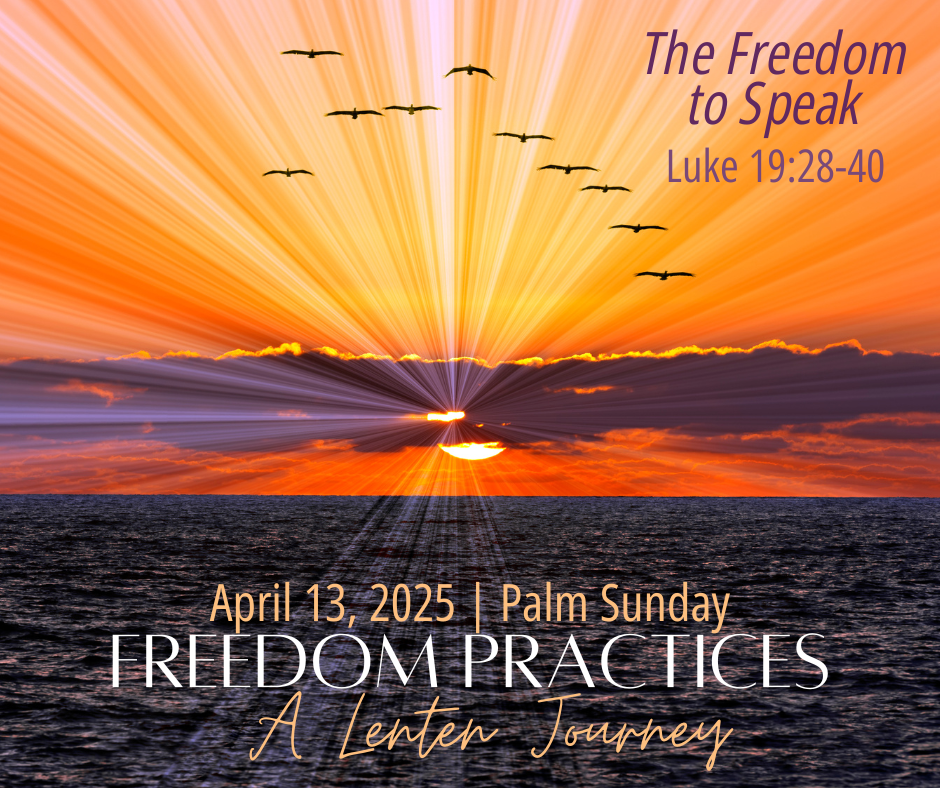Once truth is loose, it won't be stopped
Some of the Pharisees in the crowd said to Jesus, “Teacher, rebuke your disciples!”
40 “I tell you,” he replied, “if they keep quiet, the stones will cry out.”
Luke 19:39-40
Writer Annie Dillard’s essay “Teaching a Stone to Talk” tells the story of her neighbor, Larry, who tries to train a rock to speak. Much like training a parrot, he puts the stone on a shelf daily and says a few words. Dillard does not know why he decided on this action or what he hopes the rock will say. She writes, “The wonder is not that it fails, but that he keeps at it.”
Though the ritual is absurd, Dillard does not mock him for it. She sees it as a metaphor for our spiritual hunger for God. We persist even when we encounter the sheer silence of the divine in the face of our questions and sufferings. Dillard searches nature for signs of God with the rigor of a biblical scholar. She finds trees, rocks, and rivers alive with divine presence and seeks to understand their creator’s wisdom.
Biblical writers often call our attention to the wonders of nature to awaken us to the presence of God and teach us wisdom. Nature’s voice is not always passive, like a painting in a museum. Listen to this passage from the Book of Job,
But ask the animals, and they will teach you;
The birds of the air and they will tell you;
Ask the plants of the earth, and they will teach you;
And the fish of the sea will declare to you.
Who among all these does not know
That the hand of the Lord has done this?
In God’s hand is the life of every living thing
And the breath of every human being.
When Jesus tells the Pharisees the very stones would shout out, this may be more than a metaphor. Jesus often used hyperbole. He said, “It’s harder for a rich man to get to heaven than a camel through the eye of a needle. Remove the plank from your eye before the speck from your neighbors.” The stones will shout. The truth will sound no matter how you try to stop it. But what is truth Jesus brings on Palm Sunday? Why do some cheer while the Pharisees resisted? What were they afraid of? Let’s look at the scene more closely.
Multiple symbols embellish the story. Jesus begins his journey from the Mount of Olives, where Zachariah said the Messiah will appear. The close reader will notice that the chief symbol of the day, the palms, is missing from Luke’s narrative. Instead, people throw their cloaks before Jesus, and his donkey walks across the garments. Today, we roll out red carpets to honor fame, but that pales compared to laying down your cloak in the dirt.
I found only one biblical parallel: placing garments on the road when Jehu was declared king (II Kings 9:13). I doubt the royal symbolism is lost on the religious leaders as throngs of people shout praise and honor Jesus even with their clothes. It’s Passover, the highest holy day. Jerusalem is packed with pilgrims, and Jesus’s fanfare creates a significant disruption. The Pharisees fear Roman crackdowns, arrests, or riots. No pastor wants police involvement in their festival, like an arrest in the middle of the Christmas pagaent.
Meanwhile, Jesus also embraces upside-down symbolism by riding a donkey. Luke spends more time arranging for the donkey than describing the parade—so it must matter. You don’t have to be a biblical scholar to understand the difference between riding gloomy Eeyore into Jerusalem versus arriving on a mighty Arabian steed. Donkeys don’t carry kings. They carry sidekicks—Sancho Panza, not Don Quixote. They’re humble, get-it-done burden bearers. And that makes Palm Sunday hard to preach: we want to focus on the hosannas. Even the NRSV calls this the triumphal entry. But it is the entry of the one who bears burdens, not the hero who comes out on top.
By riding the donkey, Jesus repeats his message: the last shall be first, the first last, and the greatest the servant. Now, he delivers this truth to the Temple leaders—a spiritual Doordash they didn’t order and don’t want. They push back, “Make them stop Jesus, and remind them who is in charge.” Jesus answers, “Good luck with that. When the truth is loose, even stones will shout.”
We’d like to think we’re the ones throwing our LL Bean jackets in front of his donkey. But during holy week, everyone around Jesus fails. The disciples fall asleep when needed. Peter denies him three times. Judas betrays him. So, maybe we should imagine ourselves in the Pharisees sandals, asking Jesus to tone it down.
The Pharisees weren’t evil—they were guardians of tradition, trying to protect their people and their place in a delicate, dangerous balance of power. But in their concern for order, they missed the vital truth of Jesus that could set them free. It’s easy to point fingers at them, but how often do we do the same?
We silence uncomfortable truths in favor of polite religion. We ask the prophets in our midst to tone it down, to stop disturbing the peace, and to speak only of positive things. We curate our faith to be palatable, respectable, and safe. We say, “Not here, not now.”
Like the Pharisees, we may not reject the truth outright—but we push it to the margins, delay its demands, and disguise our fear of disruption as prudent caution. And all the while, the truth is undeterred because it does not need our permission. If we do not speak it, even the stones will. Truth doesn’t vanish just because we avoid it.
Yet deep down we long for a truth that is etched in stone. Humans often try to get stones to speak by making sacred monuments. We wonder at the ancient engineering feats of Stonehenge or the giant Moai statues on Easter Island. In the Old Testament, various characters place stones in memory of critical spiritual occasions. After Jacob envisioned a stairway to heaven, he built a pile of rocks, anointed it with oil, and named the place Bethel. Moses put twelve stones around Mount Sinai to remember the covenant made with God. We bury our dead with stone monuments and crosses in the hopes that they speak of eternity beyond our mortal flesh. We long for the stones of our sacred places to speak words of assurance and tell us absolute truths.
But there is a difference between carving stones to look like the God we want and listening to what the stones say. Are we trying to make stones speak, or are we trying to learn their language?
If stones do speak, Maine would be one of the noisiest places on earth. A stone ridge in my backyard rises like the curve of a whale surfacing for air. It is an information highway for traveling deer, foxes, and birds, and I learn as I observe life moving along. The Maine shore tells the geological story of the earth. Twenty thousand years ago, the last Ice Age glaciers carved deep bays and valleys out of granite and schist. Our woods are scattered with great round boulders like a giant child forgot their marbles mid-game. My first view of morning reminds me that the earth was older and active long before civilization. If Bishop Usher and the creationists who believe the world began in 4000 BCE visited Maine, they would know they were late to the creator’s party.
Walking our ancient shores reminds us of how shallow our 24-hour news cycles have become. The 15-second TikTok video with millions of views is just a wave crashing and disappearing against the rock that has seen it all come and go. Rock, stone, and mountain tell the story of the earth that began long before what we call the Stone Age.
We carve things in stone when we want them to last.
We carve names into granite walls to honor soldiers who gave everything.
We carve the image of Martin Luther King Jr. in towering marble, standing as a reminder that justice rolls down like waters.
We etch the names of first responders like firefighters, police, and nurses into the 9/11 monument, declaring that courage and compassion leave a mark on history.
We lay down headstones to whisper our grief and hope across generations.
The question is not whether the stones are speaking.
The question is whether we are listening.
If we open our hearts, we will hear truth not only etched in commandments or carved into marble, but spoken through compassion, through justice, through mercy—
Truth that does not boast but bears burdens.
Truth that kneels to wash feet, tends to the wounded, and feeds the hungry.
Because what we put into stone—what truly lasts—is not our power or our pride,
But a truth made visible in service.
So here is the question we each must answer:
What truth will your life carve into the world?
Whose burden will you help carry?
What kind of love will you leave behind, worth remembering in stone?
That is what the stones remember.
That is what they shout.
So let us listen.
And let us live a truth worth carving in stone.





